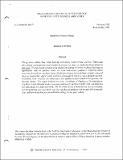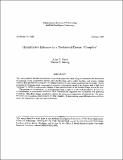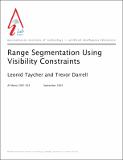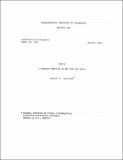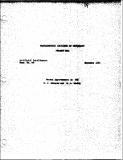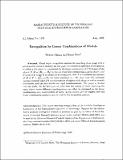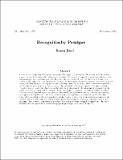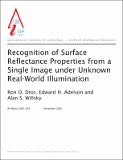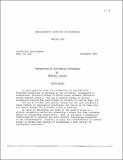Browsing AI Memos (1959 - 2004) by Title
Now showing items 877-896 of 1217
-
The Quadric Reference Surface: Theory and Applications
(1994-06-01)The conceptual component of this work is about "reference surfaces'' which are the dual of reference frames often used for shape representation purposes. The theoretical component of this work involves the question ... -
Qualitative Depth and Shape from Stereo, in Agreement with Psychophysical Evidendence
(1987-12-01)Obtaining exact depth from binocular disparities is hard if camera calibration is needed. We will show that qualitative depth information can be obtained from stereo disparities with almost no computations and with ... -
Qualitative Process Theory
(1983-05-01)Things move, collide, flow, bend, heat up, cool down, stretch, break and boil. These and other things that happen to cause changes in objects over time are intuitively characterized as processes. To understand common ... -
Quantitative Inference in a Mechanical Design Compiler
(1989-01-01)This paper presents the ideas underlying a program that takes as input a schematic of a mechanical or hydraulic power transmission system, plus specifications and a utility function, and returns catalog numbers from ... -
A Quick Fail-Safe Procedure for Determining Whether the GCD of 2 Polynomials is 1
(1967-03-01)One of the most widely used routines in an algebraic manipulation system is a polynomial manipulation package (1,2,3). The crucial operation in such routines is the extraction of the Greatest Common Divisor (GCD) of ... -
RamboNodes for the Metropolitan Ad Hoc Network
(2003-12-17)We present an algorithm to store data robustly in a large, geographically distributed network by means of localized regions of data storage that move in response to changing conditions. For example, data might migrate away ... -
Range Segmentation Using Visibility Constraints
(2001-09-01)Visibility constraints can aid the segmentation of foreground objects observed with multiple range images. In our approach, points are defined as foreground if they can be determined to occlude some {em empty space} in the ... -
A Real Time Garbage Collector Based on the Lifetimes of Objects
(1981-10-01)In previous heap storage systems, the cost of creating objects and garbage collection is independent of the lifetime of the object. Since objects with short lifetimes account for a large portion of storage use, it's ... -
Real-Time Part Position Sensing
(1988-05-01)A light stripe vision system is used to measure the location of polyhedral features of parts from a single frame of video camera output. Issues such as accuracy in locating the line segments of intersection in the image ... -
Reasoning Utility Package User's Manual, Version One
(1982-04-01)RUP (Reasoning Utility Package) is a collection of procedures for performing various computations relevant to automated reasoning. RUP contains a truth maintenance system (TMS) which can be used to perform simple ... -
REC/8: A CONVERT Compiler of REC for the PDP-8
(1968-01-01)REC/8 is a CONVERT program, realized in the CTSS LISP of Project MAC, for compiling RED expressions into the machine language of the PDP-8 computer. Since the compilation consists in its majority of subroutines calls (to ... -
Recent Improvements in DDT
(1963-11-01)This paper will report new developments and recent improvements to DDT. "Window DDT" now will remember undefined symbols and define them on a later command. Using sequence breaks, it can change the contents of memory while ... -
Reciprocal Interactions Between Motion and Form Perception
(1995-04-21)The processes underlying the perceptual analysis of visual form are believed to have minimal interaction with those subserving the perception of visual motion (Livingstone and Hubel, 1987; Victor and Conte, 1990). ... -
Recognition and Localization of Overlapping Parts from Sparse Data
(1985-06-01)This paper discusses how sparse local measurements of positions and surface normals may be used to identify and locate overlapping objects. The objects are modeled as polyhedra (or polygons) having up to six degreed ... -
Recognition and Structure from One 2D Model View: Observations on Prototypes, Object Classes and Symmetries
(1992-02-01)In this note we discuss how recognition can be achieved from a single 2D model view exploiting prior knowledge of an object's structure (e.g. symmetry). We prove that for any bilaterally symmetric 3D object one non- ... -
Recognition by Linear Combinations of Models
(1989-08-01)Visual object recognition requires the matching of an image with a set of models stored in memory. In this paper we propose an approach to recognition in which a 3-D object is represented by the linear combination of 2-D ... -
Recognition by Prototypes
(1992-12-01)A scheme for recognizing 3D objects from single 2D images is introduced. The scheme proceeds in two stages. In the first stage, the categorization stage, the image is compared to prototype objects. For each prototype, ... -
The Recognition of Sharp, Closely Spaced Edges
(1974-12-01)The recognition of sharp edges from edge- and bar-mask convolutions with an image is studied for the special case where the separation of the edges is of the order of the masks' panel-widths. Desmearing techniques are ... -
Recognition of Surface Reflectance Properties from a Single Image under Unknown Real-World Illumination
(2001-10-21)This paper describes a machine vision system that classifies reflectance properties of surfaces such as metal, plastic, or paper, under unknown real-world illumination. We demonstrate performance of our algorithm for ... -
Recognition of Topological Invariants by Modular Arrays
(1968-09-01)In this paper we study recognition of topological invariant properties of patterns by use of finite, rectangular 2-dimensional, interactive arrays of finite state automata (hereafter called modular arrays). The use of ...


